Brief substance use prevention programs hold several advantages over evidence-based programs that are lengthier or more complicated.
Before we discuss these advantages, we should first define what we mean by “brief programs.”
While there is no universally accepted definition of brief programs, generally the term refers to those interventions that are no longer than three sessions.
And while a brief program could be any type of intervention, typically they are of the screening and brief intervention variety.
That is, programs that include screening youth for their substance use and perhaps other health behaviors, providing feedback, and either referring higher risk youth for treatment and/or offering goal setting to change behavior.
Examples of evidence-based screening and brief interventions include Screening, Brief Intervention and Referral to Treatment (SBIRT) and Prevention Plus Wellness (PPW) programs such as SPORT and InShape PPW.
SBIRT and PPW are more similar than not, but the primary differences include:
- SBIRT emphasizes intervention among high-risk youth identified by screening whereas PPW emphasizes universal prevention for all participating youth;
- SBIRT screening is designed to identify youth at higher risk for substance use problems who then receive brief intervention whereas PPW screening is designed for increasing youth reflection and awareness of their current substance use and other health behaviors;
- SBIRT targets one or more substance use behaviors whereas PPW targets one or more substance use behaviors as well as healthy lifestyle behaviors, typically including physical activity and sports, healthy eating, sleep and stress control;
- SBIRT includes referral to treatment for youth at highest risk for substance use problems whereas PPW includes goal setting to avoid substance use and increase one or more health-promoting behaviors for all youth.
Advantages of Brief Interventions (BIs)
Brief interventions hold several advantages for prevention and health providers over non-brief interventions. Three prominent advantages include:
- BIs are cost effective. The benefits of brief interventions have been found to outweigh their costs: https://pubmed.ncbi.nlm.nih.gov/16767851/
The single-session SPORT Prevention Plus Wellness program, for example, has been reported to be a cost-beneficial among selected evidence-based substance use prevention programs: https://depts.washington.edu/iprg/Preventing%20youth%20substance%20abuse%20Research%20Update.pdf
- BIs can result in long-term positive outcomes on youth substance use: https://www.ncbi.nlm.nih.gov/pmc/articles/PMC6746575/
Both the SPORT Prevention Plus Wellness program for youth (https://link.springer.com/article/10.1007/s11121-005-0012-3) and the InShape Prevention Plus Wellness program for young adults (https://www.sciencedirect.com/science/article/abs/pii/S0091743509006409) have shown positive outcomes one-year later.
- BIs are also efficient and teachable to a wide range of prevention and health providers.
According to one brief intervention researcher, “The BI approach holds great promise to expand services to a wide range of youth in diverse and non-traditional settings.”: https://www.ncbi.nlm.nih.gov/pmc/articles/PMC4864856/
For example, the SPORT and InShape Prevention Plus Wellness programs have been provided to individuals across the US in nearly every setting where youth exist, including schools, colleges, youth groups, sports organizations, juvenile justice, family agencies, alcohol and drug abuse organizations, community health agencies, military organizations, and homes, to name just some.
In addition, since BIs such as SPORT and InShape PPW include manualized scripts, training time is greatly reduced and no specialized degree or experience is required to implement them. For example, high school students have been trained to provide the SPORT PPW to their same and younger-aged peers in school and other group settings.
Conclusion
Efficient, cost-effective, and with the potential to reach large proportions of youth, the advantages of brief interventions make them an invaluable resource prevention and health providers can use alone or in combination with other evidence-based strategies to enhance the prevention of harm and the promotion of wellbeing among youth and young adults.

